Wastewater Headworks Ballot Measure

Ballot Measure under discussion in Hailey regarding aging Wastewater Treatment Plant Headworks infrastructure.
Hailey City Council will be bringing a ballot measure to voters in May to replace the deteriorating Headworks infrastructure at the Wastewater Treatment Plant. Headworks is the first step in the wastewater treatment process and is essential to the efficient, ongoing operation of the Wastewater Treatment Plant. The proper functioning of this component is essential to effectively treat incoming wastewater and prevent downstream damage to the rest of the multi-million dollar treatment system. Bryson Ellsworth, Hailey Wastewater Division Manager states, “Think of Headworks like a coffee filter. Untreated wastewater flows into the headworks building, where it moves through a series of equipment that removes debris, like toilet paper, from the waste stream. Currently, this “filter” is operating at less than a 45% capture rate. Our goal is to achieve a capture rate of over 90%.” Headworks plays a vital role in the overall treatment process but is prone to aggressive deterioration due to the nature of the material it handles. The current 23-year-old headworks facility has outlived its expected lifetime of 20 years, and its replacement is the first recommended priority action item in the Wastewater Treatment Plant’s 2021 Facility Planning Study.
The City’s contracted engineer has provided three suggested system alternatives for the Headworks system – each of which would achieve a 90% capture rate. You can read the full Preliminary Engineering Report (PER) on our website. These upgrades would greatly improve the entire treatment process and lengthen the life of the equipment downstream of Headworks. Right now, the debris that is not captured in Headworks continues through the treatment process, where it can clog and damage machinery. For more detailed information on the Headworks system, please see photos and captions below:.
The Hailey Wastewater Treatment Facility is open to tours. We do encourage prior arrangements to be made to ensure that qualified staff can answer questions needed. We do not allow people to do self-tours as it is a hazardous location. Call 208-578-2211 to schedule a tour.
Above Photo Credit: Idaho Mountain Express
Below Photo Credit: Bryson Ellsworth
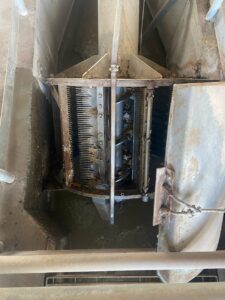
This our Fine Rake Screen, which traps debris from the waste stream. Currently, the augur which moves the debris (wipes, rags, toys, diapers, hair, etc) up to the head, has over ½-inch of play. This should be a maximum of 1/8-inch to capture the majority of the material that enters the wastewater treatment plant.
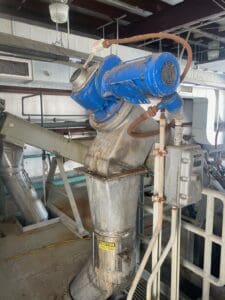
This is the head of the Fine Rake Screen. The material captured by the rake (pictured above) moves up the augur and drops into a dumpster below for disposal at the landfill. As you can see, the stainless steel is visibly deteriorating; the regular steel is brittle to the touch. Due to the low efficiency of the Fine Rake Screen, ensuring that this process is functioning has required more maintenance hours from wastewater staff every year. Occasionally, this operation has failed, putting us in danger of violating our NPDES (National Pollution Discharge Elimination System) permit.
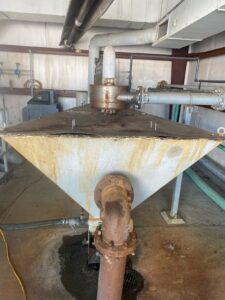
This is our grit washer. Its job is to remove the smaller items that the Fine Rake Screen cannot pick up but can cause damage to mechanical equipment or hinder the treatment process. It removes grit typically composed of small rocks, sand, eggshells, wood chips, and coffee grounds. This grit washer has had the top pump rebuilt in-house and reinforced several times. It has been failing to do its job as it is advanced in age. The grit acts like a constant sandpaper, rubbing against the washer and constantly degrading the equipment.
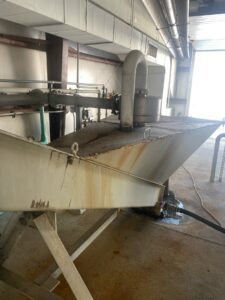
Here is another angle of the grit washer. You can see deterioration on the top and side. The grit travels up the arm to be deposited in a dumpster and disposed of.
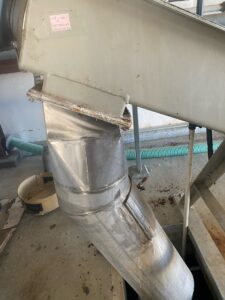
This is the head of the grit washer. The grit passes through this head as its last stop before being dropped into the dumpster below.
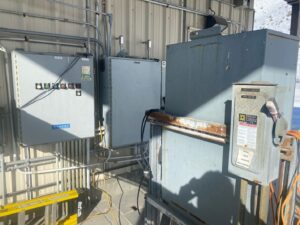
These are the electrical controls for the Headworks building and its mechanical equipment. These controls are located outside the Headworks building to help protect them from the Headworks process. However, we have found that the Headworks creates such an aggressive atmosphere, that it has caused accelerated deterioration of these panels and even the wiring inside the panels.
 This is one of the steel beams inside the Headworks building. This represents the condition of all the beams in the building. It is easy to see how aggressive the environment is, not only to the beams but even the plastic linings and the concrete below.
This is one of the steel beams inside the Headworks building. This represents the condition of all the beams in the building. It is easy to see how aggressive the environment is, not only to the beams but even the plastic linings and the concrete below.
 This is another angle of the steel beams and part of the ducting for the air removal system in the Headworks building. We have had issues with the air ventilation system due to the aggressive nature of the Headworks environment.
This is another angle of the steel beams and part of the ducting for the air removal system in the Headworks building. We have had issues with the air ventilation system due to the aggressive nature of the Headworks environment.
